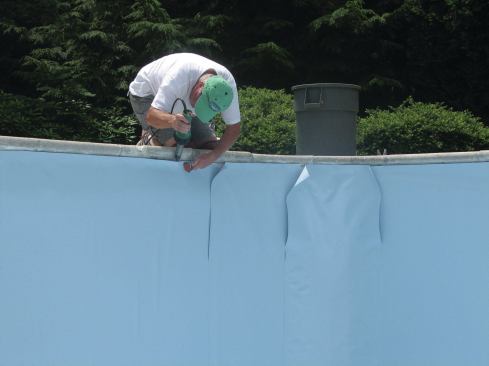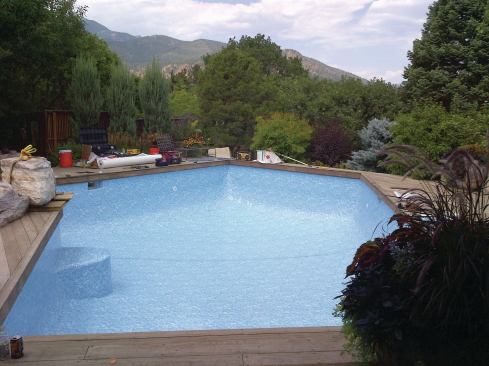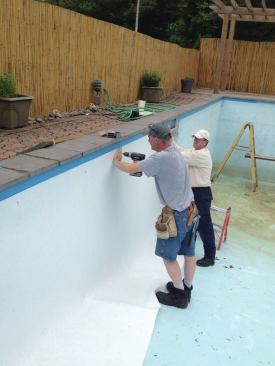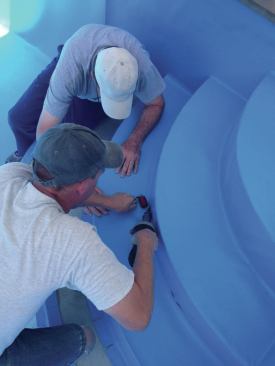MEMBRANE CONCEPTS
They build pools a little differently in Europe. Sure, they make them out of shotcrete, fiberglass and vinyl liners, but they’re also big on a certain type of waterproof shell that’s beginning to make inroads across the pond.
We’re referring to the polyvinyl chloride membrane. Consider it the beefed up cousin to the conventional vinyl liner.
Here, PSN takes closer look at the material and installation fundamentals, as well as market opportunities.
A PVC membrane is reportedly three times thicker than standard-issue vinyl, making it essentially puncture proof. It’s cut to fit on-site, pliability isn’t affected by the weather and it’s said to last decades.
“To get 20, 30 or 40 years out of this I don’t think is an unreasonable expectation,” says James Robyn.
Robyn is the CEO of New Jersey-based Park Pool and Pond Products as well as heading up BioNova Natural Pools.
It may be no coincidence then that a PVC membrane will line the nation’s first public “natural” swimming pool. The Webber Park pool in Minneapolis will boast 28,000 square feet of swimming area cleansed through a plant-based filtration system.
“Given my background I had in vinyl liner pools, it intrigued me,” Robyn says. “It occurred to me that this would be a product that would be very good at renovating old concrete pools.”
Park Pool and Pond Products became the first U.S. dealer of the material that comes from Elbtal Plastics in Deutschland, Germany.
Apparently, German engineering —which has given us some of the world’s finest automobiles — is finding a place in the pool industry, because two other prominent PVC membrane manufacturers also are in Germany, those being DLW delifol (that’s with a lowercase “d”) and Renolit.
Installers familiar with the material’s history say PVC membranes, pioneered by the Germans, came to the United States in the 1960s. In the following decades, the reinforced vinyl was primarily used for lining competition vessels, community pools and splash pads. Budget-conscious municipalities often opt for weld-on-site liners because they’re comparable in price to replastering an aging pool, requires minimal maintenance and is virtually indestructible.
“When you have a cracked pool that you have to paint every year or if you have tiles falling off, and you have to discuss your budget every year with the board of directors, many institutions choose this material because it’s fast and cheap,” says Tommy Nachmann, business development manager for Israeli manufacturer Haogenplast. “Skilled installers can do it in 10 days so you’re not shutting your pool down for long.”
In recent years, the product has found its way into backyard pools. Homeowners are choosing it for the same reason commercial pool managers are: It offers a viable alternative to replastering, which, in some cases, may only be a temporary fix.
Having conducted installation courses in more than 30 countries, Greg Solmundson has seen material hold up under extreme conditions. He believes the greatest market for membrane liners is in the northern parts of the U.S. and Canada where the freeze-thaw cycle can mean repeat repairs on swimming pools.
“Once concrete cracks, you’re chasing something that’s never going to end,” says Solmundson, owner of Ark Custom Pool & Spa, which has locations in Alberta and British Columbia, Canada.
The membrane system is unaffected by expansion or contraction because it is not bonded to the pool’s interior, unlike paint, plaster and other rigid renovation options. Instead, the material is completely suspended around the perimeter inside the shell. The pool can shift with the ground — even crack — but the liner remains intact.
Though it’s durable and watertight, Solmundson cautions that the weld-on-site liner is “not the be-all, end-all.” He’s seen a job or two go sideways because installers weren’t properly trained.
ABCs of PVC
(Note: What follows is not an exhaustive step-by-step tutorial on installation methods. It’s simply a general overview. It goes without saying, but we’ll say it anyway: For best results, follow the manufacturer’s instructions.)
PVC membranes are closely related to single-ply waterproof roofing sheets, but specially formulated to withstand the rigors of a chemically-treated pool. The material won’t affect the water balance because it’s chemically inert and its nonporous surface makes this type of liner insusceptible to staining and corrosion.
The membrane is reinforced with polyester fabric webbing sandwiched between layers of PVC, giving it a hearty 60-mil thickness.
The liner can go over any structurally sound shell (concrete, fiberglass, steel, etc.). There is no need to sandblast and prep the surface to perfection, though you may want to apply a sanitizer over the entire surface area of the pool to prevent fungus from growing behind the membrane.
It’ll arrive in heavy, 400-square-foot rolls, measuring about six feet long.
Begin by fastening a series of flexible, PVC-coated stainless steel strips along the perimeter under the coping. (We’ll explain why in a minute.) Then apply a nonwoven geotextile fabric to the interior of the pool. This padding serves as a slip sheet, allowing the pool to shift under the membrane and will smooth out the rough, calcified surface.
As mentioned earlier, the material is tailored to the pool on-site. Once the pieces have been measured and cut, they’ll be overlapped by two to three inches. Using a hot-air blower, first create a tack weld about an inch and a half inside the overlap to hold the pieces in position.
Weld the membrane directly to the band of PVC under the coping, using a roller over the surface as you go along. (This only applies to gunite and fiberglass pools. For steel wall pools, you can use the existing track.)
Then do a more thorough weld along the inner tack, and then along the edge of the overlapping material, starting with the walls, then the floor, forming one continuous watertight blanket. Attention to detail at this stage is critical. You need to ensure that you’re creating a thorough bond.
Where things get tricky is around corners and steps where you may need to do a triple overlap of the material. Make doubly sure there are no vulnerabilities. Cut the material around the return lines, drains, lights and other penetrations and affix stainless steel fasteners around them.
Finish by applying liquid PVC along the seams. This rounds out the seams and adds another waterproofing measure.
“Think of it like wrapping a Christmas present,” says Ron Melbourne, owner of Membrane Concepts, a New Bedford, Mass., firm that does installations nationwide. (Clients include the U.S. Olympic Training Center, Metropolitan Museum of Art … oh, and the White House.) “It comes out real nice, but it’s quite labor intensive.”
Be sure to take advantage of any training opportunities your dealer may provide.
“It’s easy once you’re trained and have a little bit of practice,” says Carol Payer-Cooper, sales and marketing manager for Park Pool and Pond Products. “If you’re not experienced with this, I would not recommend that you say ‘Yeah, I’ve used a welding gun before. I think I’m going to go out and do a pool.’ You need to make sure that this is watertight and there’s a definite process to ensure that.”
A foreign concept
The material has long been a common residential application in Europe where weld-on-site liners are used in approximately 30 percent of backyard pools in eastern countries and as much as 90 percent in some western countries, manufacturers say. ?Why hasn’t it caught on in North America?
“Not everything that’s sold in Europe can be sold in the States, and the opposite,” Nachmann explains. “It’s a question of taste and fashion.”
It’s also a question of establishing and training a network of installers, which European manufacturers have done exceptionally well. North American suppliers are taking note.
Canadian General Tower, a major player in the conventional vinyl liner market, is supplying a triple-ply product to France where the material is gaining ground.
The Cambridge, Ontario manufacturer may begin marketing PVC membranes as a residential renovation product in the U.S. and Canada, as well.
“It’s something we’re investigating at the moment, what part we can play in training installers in North America,” says Adam Peaker, vice president of industrial sales. “That’s a key part of it being accepted in North America.”
Lost in translation
If you were to read poorly translated brochures about PVC membranes, you might envision a pool shell layered in wool and foil.
Developed in Germany, reinforced vinyl has several words associated with it that can cause some confusion to English readers. The German word “vlies,” which sounds a whole lot like the English “fleece,” refers to the geotextile fabric that is applied to the pool before the membrane.
And then there is the liner itself, called “folie.” You might find some materials incorrectly referring to the liner as the stuff you use to wrap food.



